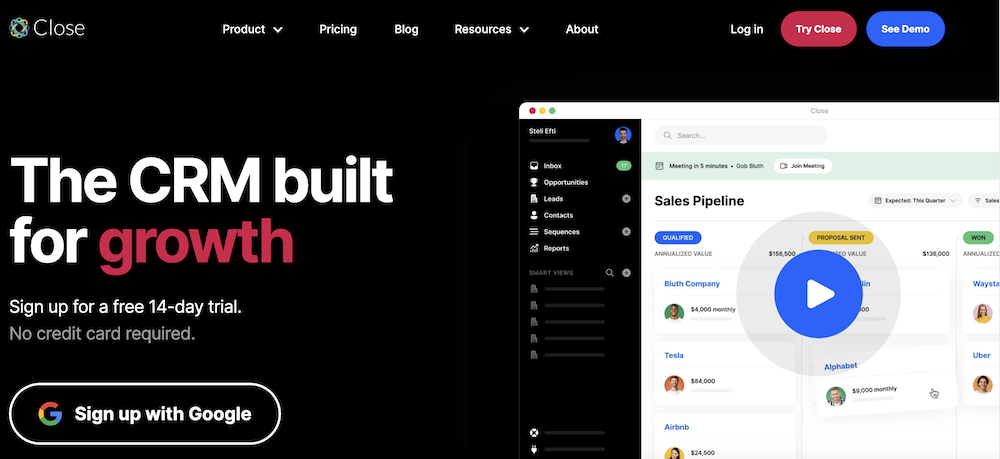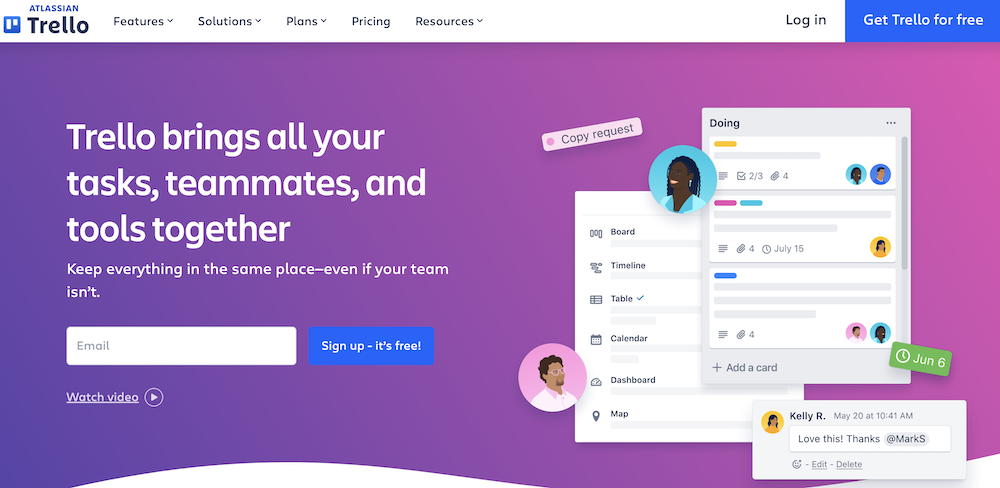As a small business owner, successful lead generation is one of the ways to validate your business idea and grow your business.
While it is better handled by a sales or marketing professional, you may want to handle it yourself for one reason or another. We understand. Every big business today was once a small business with limited resources.
That’s why we want to share some actionable strategies with you on how to generate leads for your small business. Let’s get started.
Understanding Lead Generation for Small Business
Lead generation is attracting those who aren’t yet customers and getting them interested in your product or service.
Aside from getting customers, lead generation also plays a pivotal role in validating your business idea, generating revenue, and securing funding.
Need an example? Look at Airbnb. Airbnb is an accommodation-sharing platform that lets you rent out your properties and spare rooms to guests for a short-term stay.
According to “The Airbnb Story” by Leigh Gallagher, up until they rented out their apartment when a design conference came to town, Airbnb remained a crazy idea that no investor would touch with a 10-foot pole. And that was the turning point.
The tactics to generate these leads can include inbound marketing strategies such as content marketing, SEO (search engine optimization), and social media, or outbound tactics like cold calling and email marketing. Let’s discuss why lead generation is so important, before delving into specific tactics.
Why Lead Generation Matters
According to Ruler Analytics, 91 percent of marketers say lead generation is their most important goal. The reason is simple: you can’t have customers without leads.
But lead generation is also important for:
- Building a customer database: Lead generation helps build a database of potential customers. This database can be leveraged for future marketing campaigns and customer engagement initiatives.
- Business growth: A steady flow of qualified leads fuels business growth. More leads mean more opportunities for sales, conversions, and revenue generation.
- Measuring marketing effectiveness: Lead generation is one of the metrics you need to track to measure the effectiveness of your marketing campaigns. It helps you see whether your marketing is hitting its target and calculate its return on investment (ROI).
- Brand awareness: Effective lead generation strategies create brand awareness. Even if leads don’t immediately convert, they become familiar with your brand, making them more likely to consider you in the future.
7 Tips to Implement a Successful Lead Generation Strategy
You can’t implement all the lead-generation strategies in the world, but you can pick the ones that work best for you and implement them well.
Let’s say you’ve seen that your budget and team size can only accommodate SEO and email marketing at the moment. Work with that first, and then scale.
Our goal in this section is to provide you with a list of effective lead-generation strategies for small businesses and show you how to implement them.
1. Build Out an SEO and Content Marketing Strategy
High-quality content is the core of any successful lead-generation strategy, and SEO is its driver and one of the most important distribution channels.
When you offer valuable, in-depth content, you attract website visitors interested in what you’re selling. No wonder the content marketing conversion rate is six times higher than all other strategies, according to research.
Also, if you consider how SEO and content marketing work, this makes even more sense: someone searching for something on Google is likely more problem-aware than someone who saw an ad.
While SEO and content marketing for lead generation require specialist knowledge, here are some basics to get you started:
- Start with your ideal customer profile (ICP): Content marketing has evolved beyond starting with keyword research. Before entering any keyword into your keyword research tool, first map out your ICP to see what they’re searching for. This action enables you to uncover their pain points and tailor your keyword research as necessary.
- Keyword research: Knowing your ICP will give you ideas of what their search queries are. Enter those queries into your keyword research tool to find long-tail and short-tail keywords you can go after. You can use that information to create a topic cluster and develop topical authority.
- Create high-quality content: All the early research will give you insights into your customer’s pain points, which you should address in your articles. The secret sauce here is to make your content helpful—tailor it to their needs. This content can be in the form of an article, a video, or infographics.
- Optimize content for SEO: To generate leads, your quality content needs to be found. By naturally including your target keywords in your content’s titles, headings, meta descriptions, and main content body, you can improve its chances of ranking high on Google. Make the content well-structured, easy to read, and mobile-friendly.
- Leverage on-page SEO: On-page SEO involves internal linking, using descriptive URLs, adding meta tags, writing a good meta description, adding an alt tag to your images, and so on. These are some of the ranking signals Google will use to determine the quality of your page.
- Build backlinks: High-quality backlinks from reputable websites remain one of the most important ranking factors. Guest posting, partnerships, and relationship building with influencers are some of the ways to get backlinks. Most importantly, publish linkable assets such as stats and thought-leadership content.
- Promote your content: Although the jury is still out on whether this is actually a ranking factor, distribute your content on social media to get traffic.
- Monitor performance and analytics: Regularly monitor your website’s performance using tools like Google Analytics. Analyze user behavior, traffic sources, and content engagement to make data-driven decisions for improvement.
For more information, check out Moz’s comprehensive SEO guide.

2. Leverage Social Media Paid and Free Opportunities
Social media platforms are a potent tool for small business lead generation. LinkedIn, Instagram, Facebook, and TikTok are all potent in their own way, even if you’re in the SaaS industry.
The key here is to be active and engage with your audience by sharing valuable content and responding to queries promptly.
Our comprehensive guide on how to generate leads from LinkedIn covers LinkedIn lead generation in detail.
But for your overall social media lead generation campaign, take the following steps:
- Create engaging content: The rule of thumb for social media lead generation is to be engaging. Whether that’s written content, videos, memes, infographics, and so on, create relevant, helpful, and engaging content. That’s how leads will find you.
- Use social media advertising: Each platform offers different advertising options for small businesses. If you want to get quick results, this is an option you should consider. Instead of using an organic strategy, which takes time, lead generation ads will capture leads almost as soon as you run them.
- Participate in social media groups: Join relevant social media groups and contribute by offering useful advice. Users are more likely to contact or search for you online if they frequently benefit from your content.
- Use influencer marketing: Some social media influencers have a wider reach than you can dream of as a small business owner. You can partner with relevant ones to attract new leads and raise awareness for your business.
- Call-to-Action (CTA): Include clear and compelling CTAs in relevant social media posts, encouraging users to take action, such as signing up for a newsletter, downloading a free e-book, or requesting a demo.
3. Host Webinars to Capture Leads and Generate Demand
Webinars are an excellent tool for both B2B and B2C businesses. They offer an opportunity to demonstrate your expertise in your field, provide value to your audience, and collect contact information from attendees.
You can attract potential clients and move them through your sales funnel by offering high-quality, informative webinars. It’s also a good place to create demand for your products or services by getting the audience interested in what your business can do for them.
To generate leads from your webinar, these are the steps you should take:
- Collect information during registration: In the initial registration form, ask for essential lead information, such as name, email address, job title, and company. However, keep the form simple, and only ask for just enough information upfront. Anyone interested in your webinar will likely be interested in your solution, too.
- Do post-webinar follow-up: After the webinar, send follow-up emails to attendees and non-attendees. Share the webinar recording, slides, and additional resources. Engage with attendees to address any further inquiries or provide personalized assistance.
- Offer incentives: You can offer incentives, such as a free downloadable resource or exclusive access to additional content after the webinar, to get your attendees to drop their contacts.
4. Build a Referral Program to Get Quality Leads
Referral programs are one of the best lead sources for your business. If a lead lands on your doorstep because someone they trust recommends you, their chances of converting significantly increase.
Happy customers are often willing to refer their friends and family to your business, especially if incentivized with a referral program.
This is how to use referral programs to generate leads for your business:
- Identify the most suitable incentives: Offer appealing incentives to referrers and customers. Consider discounts, cash rewards, free products, or exclusive access to special offers.
- Create a simple referral process: Keep the referral process easy and straightforward. One way to do that is to provide a unique referral link or code to each referrer to track their referrals accurately.
- Promote the referral program: Spread the word about your referral program through various channels, including email newsletters, social media, your website, and physical marketing materials.
- Track and reward referrals: Implement a system to track referrals accurately and ensure timely rewards for successful referrals. Show appreciation to referrers for their efforts.
5. Use Cold Calling to Reach Decision Makers
Cold calling might be as old as the hills, but it’s highly effective for lead generation, especially if you’re a B2B organization.
The trick is to approach it strategically, targeting businesses or individuals that fit your customer profile and offering them real value.
A targeted, personalized cold call is also the best way to reach decision-makers who you may not be able to reach easily through inbound marketing.
Here are four things to make your cold calling effective:
- Know your customers: Before you start cold calling, thoroughly research and understand your target customers. This involves identifying their needs, pain points, and preferences. Knowing the prospect helps tailor the cold calling approach to address their concerns and offer relevant solutions.
- Get to know them: Rather than pitching them immediately, take the cold call as an opportunity to get to know your prospects. Ask them about their immediate concerns and business needs to understand how to present your offer. That’s how you build relationships.
- Personalize your pitch: Customize the pitch to resonate with the prospect’s specific needs using the information gathered during the call. Avoid a one-size-fits-all approach and demonstrate that you understand their concerns. A personalized pitch makes the prospect feel valued and increases the likelihood of further engagement.
- Use cold calling scripts: While personalization is crucial, having a well-prepared cold calling script can provide a structured framework for the conversation. The script should include key points to cover, essential questions to ask, and potential objections to address. However, avoid sounding robotic and allow room for natural conversation.
6. Start Email Marketing to Nurture Leads
As you run your content marketing and social media lead-generation campaigns, don’t forget to build an email list.
You can do this via lead-capturing methods such as forms on landing pages, pop-ups on your website, or social media marketing, which we’ve touched on earlier.
Once you have this list, nurture these leads with regular newsletters and promotional offers. Email marketing tools like Mailchimp offer segmentation, personalization, and automation functionality to make you more efficient.
7. Deliver Quality Customer Support to Retain Customers
When leads successfully troop in, you’ll need good customer support to retain them.
When potential customers see you as responsive and helpful, they will likely choose your business over the competition. This can also drive referrals, further enhancing your lead-generation efforts.
The good news is: customer support isn’t rocket science. We can summarize quality customer support into the following steps:
- Provide a prompt response: Respond to customer inquiries and support requests promptly. Aim to address their concerns within a reasonable timeframe, showing you value their time and needs.
- Show empathy and understanding: Show empathy and understanding towards customers’ challenges and frustrations. Make them feel heard and valued, even if their issues are not immediately resolved.
- Be transparent: Clearly communicate any limitations, challenges, and friction points customers may experience with your business. When they know what to expect, they won’t be too disappointed if something doesn’t go too well.
- Offer multi-channel support: Your leads will have different preferred channels of communication. Make it easy for them to interact with you, whether on social media, email, live chat, or phone.
- 24/7 Availability (if possible): If feasible, consider offering 24/7 customer support or chatbot assistance to cater to customers in different time zones and provide immediate help when needed.
Using Lead Generation Tools for Small Business
If you want to move fast, you must automate some of your lead generation tasks, e.g., drip campaigns. Besides, there are so many parts you can’t do manually.
In this section, we’ll explore some lead-generation tools that will make you more efficient.
CRM Tools
CRM (Customer Relationship Management) tools like Close provide a range of features to aid in lead generation. They offer email marketing automation, lead capture forms, landing page templates, and more.
Plus, they streamline the sales process by giving your sales team easy access to lead and customer information, improving follow-up and conversion rates.
Close and Zoho CRM are two good CRM solutions you can consider.

Lead Generation and Prospecting Sales Tools
Lead generation and prospecting tools are important because they will help you streamline and automate finding and engaging leads.
Instead of spending hours searching for leads manually, you can access prospecting tools’ databases, which usually contain up-to-date, relevant information on your target accounts.
Some of them also help you verify leads’ email addresses on the go, which will limit your email bounce rate. Some lead generation and prospecting tools we trust are ZoomInfo and Leedfeeder.
Collaboration Tools
Collaboration tools facilitate seamless communication and teamwork among your sales and marketing teams. Use them for real-time collaboration, efficient sharing of leads and customer insights, and effective coordinated efforts to nurture prospects. Slack and Trello are good tools you should consider for this.

Inbound Marketing Tools
Inbound marketing tools are used to support your inbound marketing activities, such as keyword research, social media management, content creation, and analytics.
You can use Ahrefs for keyword research and link building, Buffer for social media management and analytics, and Google Analytics 4 (GA4) to analyze your website’s performance.
Lead Generation Campaign Metrics You Should Track
One way to tell whether the above strategies are working is by measuring them. And if you find them to be effective, measuring them will help you improve them.
CRM and other lead generation tools often provide in-built analytics for this purpose.
Here are the most important lead generation metrics you should track:
Website Traffic
This is important to measure the effectiveness of your SEO and content marketing efforts. To track website traffic, connect your website to Google Analytics to see the number of visitors your site is receiving, which pages they visit, their session, and the traffic source.
Conversion Rate
To track how many of your website or page visitors are taking desired actions, such as signing up for a free trial or your newsletter, divide the number of conversions by the total number of visitors. This shows how well your landing page or call-to-action (CTA) converts.
For instance, if you had 500 conversions from a total of 10,000 website visitors during a specific period, the conversion rate would be calculated as:
Conversion Rate = 500 / 10,000 = 0.05
Cost Per Lead (CPL)
You also need to know how much it costs to acquire each lead. This helps you assess the efficiency of your marketing campaigns. To find out, divide your marketing campaign expenses by the number of leads generated during a particular period.
Suppose you spent $1,000 on a marketing campaign during a particular month and generated 100 leads during that period. The Cost per Lead (CPL) would be calculated as:
CPL = $1,000 / 100 = $10
Lead-to-Customer Conversion Rate
Since lead generation isn’t the end goal, you need to measure the percentage of leads that eventually become paying customers.
To calculate it, divide the number of customers acquired by the total number of leads and multiply by 100 to get the lead-to-customer conversion rate.
Let’s say you acquired 50 customers from 500 leads generated during a marketing campaign. The lead-to-customer conversion rate would be calculated as:
Conversion Rate = (50 / 500) * 100 = 10 percent
Return on investment (ROI)
This is how you know if you’re gaining or losing on your lead generation efforts. The ROI tells you if your lead generation is profitable or otherwise by looking at the amount of money you spent on lead generation vs. the revenue you generated.
To track it, subtract the total marketing expenses from the total revenue generated, divide by the marketing expenses, and multiply by 100 to get the ROI percentage.
For example, if you generated $50,000 in revenue from a marketing campaign that cost $10,000 in expenses, the ROI would be calculated as:
ROI = (($50,000 – $10,000) / $10,000) * 100 = 400 percent
Use Our Tested and Trusted Lead Generation Strategies to Drive Business Growth
Generating new leads is a multi-faceted process that requires careful planning and execution. You can build a comprehensive lead generation strategy that attracts and converts high-quality leads by combining content marketing, SEO, social media, email marketing, webinars, CRM, referral programs, cold calling, and exceptional customer support.
